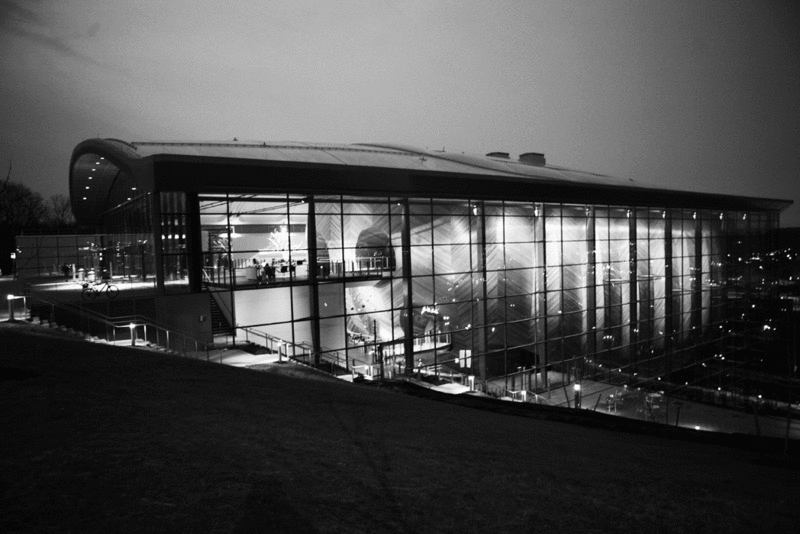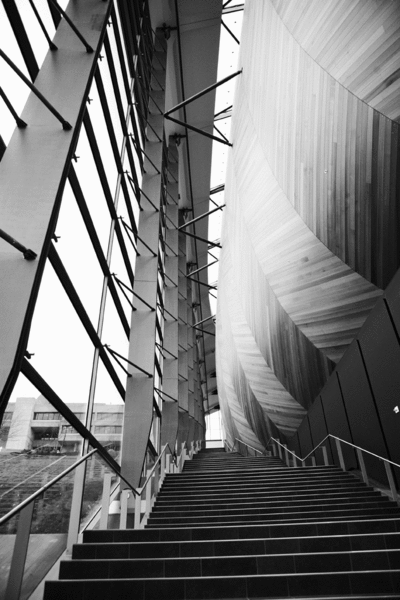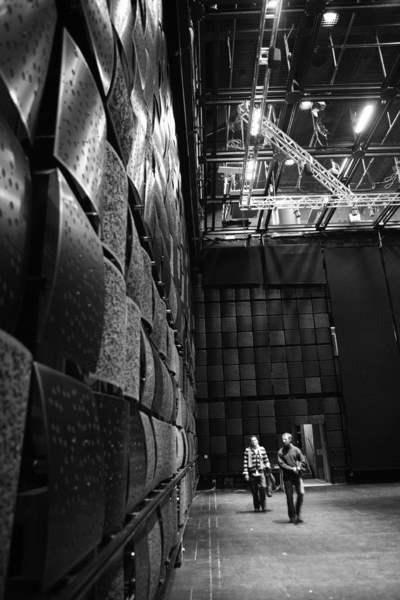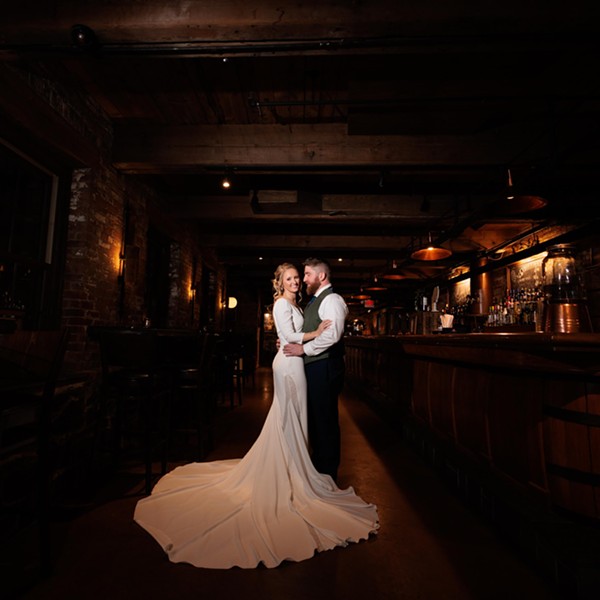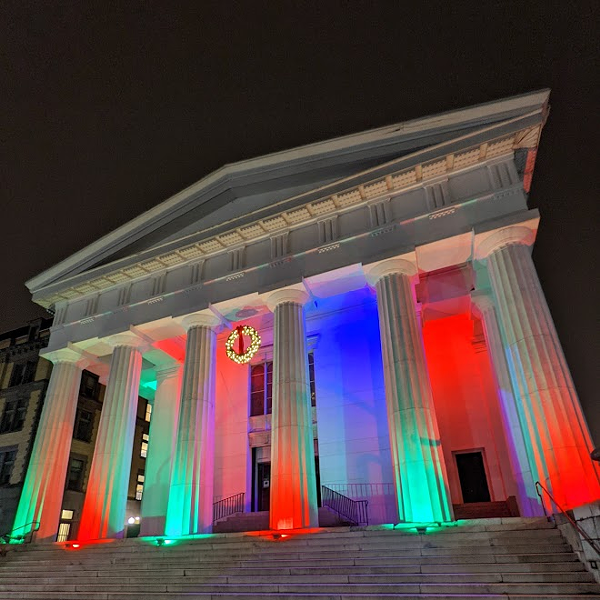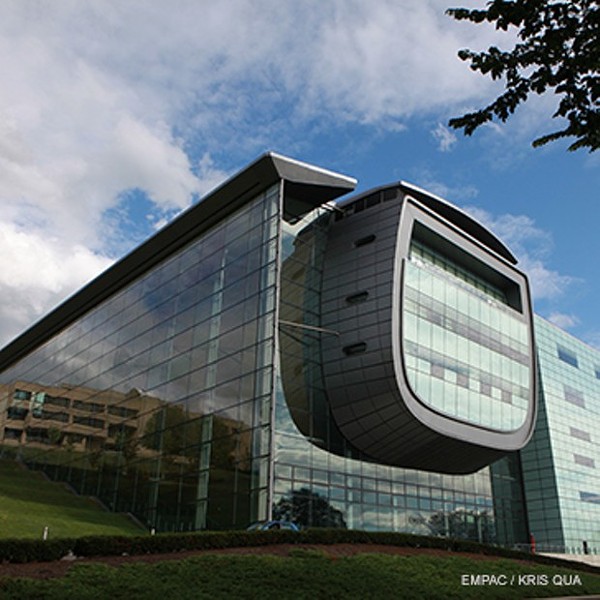Rennselaer Polytechnic Institute’s neck-breakingly massive EMPAC building looms out of the November mist like the gleaming, glass-walled craft of some far-flung future planet. Visible through the imposing edifice’s high windows is the curvaceous, wood-skinned hull of the 1,200-seat concert hall.
Inside the 220,000-square-foot, $200 million complex the sci-fi sensations continue. In one of the two cubelike studio spaces, both of which are reconfigurable as traditional black-box theaters or “clean” installation sites, a team of students and producer-engineers have set up a remotely linked recording console to capture the music of a chamber group in the neighboring hall. Above the blinking lights of the mixing board and a few nice-touch lava lamps, a large four-way-split video screen displays the musicians from different angles. In a distant corner of the building is its remaining performance environment, a 400-capacity secondary theater, which is abuzz with a crew positioning programmable lighting rigs and setting up for another event’s rehearsal. All four main spaces are lined with custom-made, dimpled convex and concave acoustical panels that further accent the structure’s space-station ambience. It’s utterly inescapable, the sense that one has crossed over into whatever impossibly advanced world it is that birthed this mammoth mothership.
Actually, it was the Troy college’s directors and British architectural firm Grimshaw—plus a generous anonymous donor—who conceived the futuristic center, which, when it comes to being a bespoke incubator of truly cutting-edge performing arts, is quite literally a world all its own. In fact, for the site’s featured artists and their audiences one could say that EMPAC (an acronym for Experimental Media and Performing Arts Center) represents a far better creative world than the earthly one they leave on the other side of the portal. This completely wired facility was designed from inception to completion to be the most acoustically perfect and infinitely adaptable facility of its kind, “a place and program where the arts, science, and technology will challenge and transform each other,” according to EMPAC’s promotional material.
“[EMPAC] is totally unique, there is no other place like it,” says German-born Johannes Goebel, who is the center’s director as well as a composer with architectural experience. Within the walls are miles and miles of fiber-optic cables linking all of the spaces and allowing the transmission of the highest-definition audio and video signals and data from one area to the next; additionally, any or all of the spaces and all of the equipment in each of them can be controlled from a single computer. And the acoustics and sightlines in each self-contained venue are beyond flawless.
“When we were thinking about the design, we knew we had to focus on having the best quality when it comes to seeing, hearing, and [the performers’ ability to move] in space,” Goebel says during a tour of the concert hall. “Some people might ask why it’s so important to put so much money and effort into something like getting the acoustics to be as perfect as they can be and doing whatever we can do to make the spaces as silent as scientifically possible. To them I would say that they should step back and take a look at the world, to consider just how much noise there is in it, and to think about how distracting that can be. So we’ve done things like eliminate the noisy overhead ventilation systems theaters always seem to have, and instead we’ve fitted ultra-quiet air ducts under each of the [concert hall] seats, to keep everything as silent as can be. With the design of the hall and the sound-diffusing ceiling and walls, it’s like having a blank canvas. It’s really unbelievable if you haven’t experienced it before.” As if on cue, a cellist on the stage at the opposite end of the huge, vaulted room bows a line. The clarity is astounding, as if she’s playing one row over.
EMPAC opened in October 2008 and immediately embarked on its dizzyingly diverse mission of programming a rich and varied selection of artists, both widely known and obscure, whose work has benefited not only from the site’s sound-and-sight-complementing design but also from the endlessly enhancing possibilities of its lablike, technologically assisted infrastructure. Since its debut, EMPAC has presented the likes of the Jazz at Lincoln Center Orchestra with Wynton Marsalis; the Wooster Group collective’s interactive panorama film There’s Still Time…Brother on floor-to-ceiling, 360-degree wall screens in black-box Studio 1; Scottish artist Billy Cowie’s 3-D holographic video installation In the Flesh; a dance party with DJs Madlib, J. Rocc, and Juiceboxxx; Voyage, a piece by Japanese collective Dumb Type combining sounds, dance, text, and projected images; a rare poetry reading by avant-jazz pianist Cecil Taylor; and numerous other innovative productions.
“But [EMPAC] is not just a place for performance or display,” Goebel says. “It’s also a place for research, for artists to work out ideas, to try out concepts before they present them to the public. So we also have several artists in residency at any given time who are here to develop certain projects that may or may not end up being presented on site. These projects might be being worked on here for presentation somewhere else in the world.”
One such body in residence is digital arts trio the OpenEnded Group, which is currently ensconced at EMPAC to woodshed Upending, a collaboration with composer Maryanne Amacher set to premiere at the center in 2010. “[Working on the piece at EMPAC] has been totally ideal for us,” says the collective’s Paul Kaiser. “What we do straddles the line between installation and stage production, so in the past we’ve had to compromise our art due to the limitations of the other spaces we’ve shown in. But EMPAC is built to be adaptable to whatever we’re doing—[at EMPAC] we don’t have to work the audio or video aspects around the layout, like we would at a traditional theater or museum space. Instead, the technology can be customized to suit our ideas. Plus it’s great to be able to work with a staff that not only understands the possibilities of the technology but that also very much appreciates the kind of art we do.”
Perfectly embodying the inventive synthesis of creativity and state-of-the-art science among the faculty is Kingston’s Pauline Oliveros, who has taught at RPI since 2000. In October she conducted a workshop on her revolutionary Deep Listening artistic practice and performed in a duo with Cecil Taylor in the concert hall. “[The concert] was really special, not only because it was the first time Cecil and I had played together, but also because of the hall itself,” says the renowned composer and musician whose influential career stretches back over 40 years. “I’d say it’s the best-sounding venue I’ve ever played in.” (The performance was recorded for an upcoming DVD release.)
“But besides [EMPAC’s] being great for the artists, the students and the audiences just get so much more out of [the productions] than they might with those of a ‘normal’ venue,” Oliveros adds. “Having an environment that’s ‘tuneable’ to the artists’ needs just really makes all the difference as far as the final results are concerned. And it’s so wonderful that that the artists and the technicians get to hang out together, to get to know each other and really work together on the projects.”
Legions of fatalists worry loudly that meaningful art is being steadily supplanted by the perceived soulless, byte-crunching heart of the new technology. But like no other institution before it, the center makes another case: that the interface between art and science is just that, a current that flows both ways. Besides utilizing technological innovation to the advantage of the art it nurtures and presents, EMPAC is keeping firmly in place the personal essence at the core of all creative endeavor. Within its wired walls and hivelike halls breathes the soul of a very human machine.
Phillipe Parreno and Douglas Gordon’s postmodern documentary Zidane: A 21st-Century Portrait screens in the EMPAC Theater on February 27 at 8pm. Multimedia artist Cathy Weis performs her Electric Haiku: The Bottom Fell Out of the Tub, Calm as Custard in EMPAC’s Theater 1 on February 6 and 7 at 8pm. www.empac.rpi.edu.







